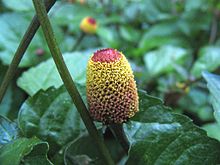Acmella oleracea
| Acmella oleracea | |
|---|---|
 |
|
| Scientific classification | |
| Kingdom: | Plantae |
| (unranked): | Angiosperms |
| (unranked): | Eudicots |
| (unranked): | Asterids |
| Order: | Asterales |
| Family: | Asteraceae |
| Genus: | Acmella |
| Species: | A. oleracea |
| Binomial name | |
|
Acmella oleracea (L.) R.K.Jansen |
|
| Synonyms | |
Acmella oleracea is a species of flowering herb in the family Asteraceae. Common names include toothache plant,paracress,sechuan button,buzz buttons and electric daisy. In Brazil it is called jambu. Its native distribution is unclear, but it is likely derived from a Brazilian Acmella species. It is grown as an ornamental and attracts fireflies when in bloom. It is used as a medicinal remedy in various parts of the world. A small, erect plant, it grows quickly and bears gold and red inflorescences. It is frost-sensitive but perennial in warmer climates.
For culinary purposes, small amounts of shredded fresh leaves are said to add a unique flavour to salads. Cooked leaves lose their strong flavour and may be used as leafy greens. Both fresh and cooked leaves are used in dishes such as stews in northern Brazil, especially in the state of Pará. They are combined with chilis and garlic to add flavor and vitamins to other foods.
The flower bud has a grassy taste followed by a strong tingling or numbing sensation and often excessive salivation, with a cooling sensation in the throat. The buds are known as "buzz buttons", "Szechuan buttons", "sansho buttons", and "electric buttons". In India, they are used as flavoring in chewing tobacco.
A concentrated extract of the Spilanthes plant identified as Jambu is used as a flavoring agent in many countries worldwide. EFSA and JECFA reviewed a feeding study in rats conducted by Moore et al. and both authorities recognized that the no adverse effect level for spilanthol was 572 mg/kg b.w./day, yielding a safe dose of spilanthol of 1.9 mg/kg b.w./day, or 133.5 mg/70-kg male/day, 111 mg/58-kg female/day, or 38 mg/20-kg child/day.
Jambu extract as a food flavoring is described as having a citrus, herbal, tropical or musty odor, and its taste can be described as pungent, cooling, tingling, numbing, or effervescent. Thus, as described, the flavor use of jambu extract includes the ability induce a mouth-watering sensation in the oral cavity and the ability to promote the production of saliva. Spilanthol, the major constituent of jambu extract, is responsible for the perception of a mouth-watering flavor sensation, as well as the ability to promote salivation as a sialogogue, perhaps through its astringent action or its pungent taste in the oral cavity.
...
Wikipedia
